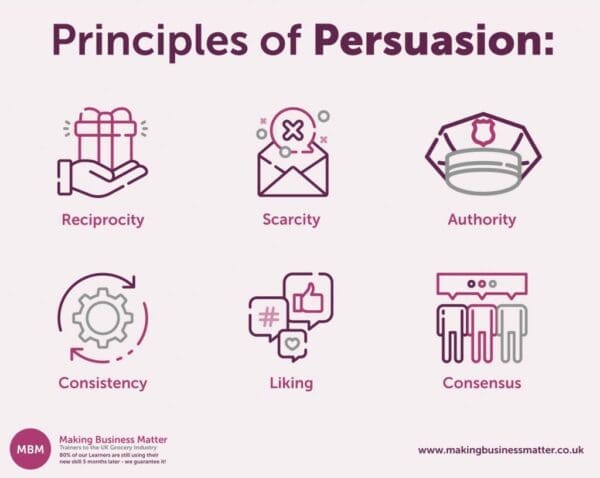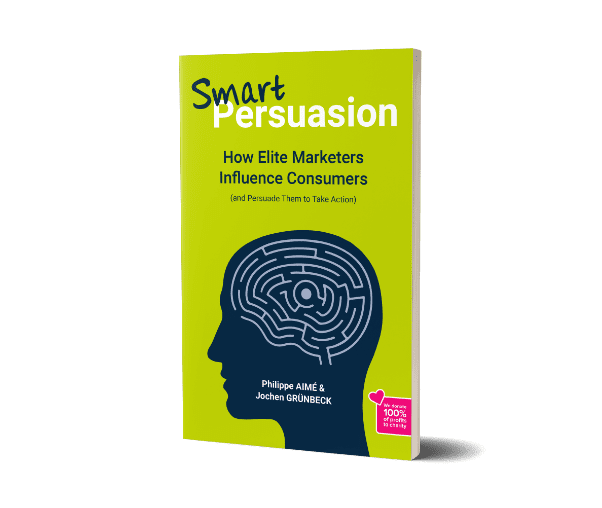You and I Need to Talk
Effective persuasion is a vital soft skill in business, the key to motivating change. It appeals not just to our reason with facts and logic, but our feelings too. As teams become more diverse and our environment more complex, success depends on sharing goals, overcoming differences and collaborating creatively. And effective persuasion has a crucial role.
In this article, we explore why effective persuasion matters more than ever. We look at the psychology involved in persuasive communication. And then it’s down to business. We consider the essentials: knowing your audience, establishing credibility: connecting emotionally: and conveying the benefits of propositions.
It’s been said that persuaders seek to change others’ cherished beliefs, but negotiators accept and reconcile diverse perspectives and lifestyles. As businesses embrace diversity, it’s time for persuaders to become more like negotiators and ‘Think responsibly.’
Sharing the Vision by Being Persuasive
Successful leaders and managers adapt their styles to the circumstances and the individuals they’re dealing with. The authoritative leadership that historically characterised much of British business is not enough now:
- As businesses flex and pivot in today’s fluid environment, empathy, agility and resilience are all important. Leaders and managers need to motivate their teams to embrace their chosen strategy.
- Working from home in the lockdowns has changed our expectations of work. Workers of all ages are actively questioning why they should return to their old routine.
- The stress of the pandemic means businesses need to promote employees’ health and wellbeing and listen to them.
- Demands for equality, diversity and inclusivity require effective persuasion, but with fairness and compassion.
- The environmental crisis puts pressure on businesses to be more sustainable, and persuade supply chain partners to follow suit.

Are You Thinking What I’m Thinking?
Defining Persuasion
The Encyclopaedia Britannia’s definition is clear on this. “Persuasion is the process by which a person’s attitudes or behaviour are, without duress, influenced by communication from other people.” The critical phrase is “without duress.” As Britannica reminds us, our attitudes and behaviour are also affected by other factors influencing our response to persuasion. These include verbal threats, physical coercion and our physiological and emotional state.
The Psychology of Persuasion
We are neurologically programmed from infancy, to seek connections with others that are beneficial. When we choose to connect with someone because we recognise the likely benefit, this is cognitive empathy. However, life experience teaches us to put up boundaries to keep ourselves safe. When people use persuasion to manipulate us into relaxing our boundaries despite our resistance, therapists call this cognitive distortion. We know when this is happening because we instinctively analyse our feelings and responses to situations and messages. Effective persuasion needs to take all this into account.

Persuasion, or Manipulation?
Persuasion usually brings positive outcomes. By contrast, manipulation is the act of controlling or playing upon someone by artful, unfair or insidious means, especially to one’s own advantage. Manipulative and abusive bosses and colleagues, we’re onto you!
Let’s Get Down to Business
As we’ve said, effective persuasion appeals to reason with facts and logic but also appeals to emotions. It involves knowing the audience, getting their attention and connecting emotionally: establishing credibility: conveying the benefits: and listening.
The elements of persuasion can be summarised as:
- Establish your credibility.
- Make your request reasonable and precise.
- Tie the facts to the benefits.
- Overcome resistance and build connection.
There are five basic factors in how effective your persuasion is likely to be:
- Source: who is it coming from?
- Message: what are you saying?
- Medium: how are you putting it across?
- Audience: who are you saying it to?
- Effect: what do you expect as a result?
Persuasive messages have three critical elements:
- The credibility of the argument.
- The strength of the argument.
- The communicator’s ability to move the audience emotionally.
You Needn’t be the Boss to be Persuasive
To persuade your audience, first, you must demonstrate your credibility and authority. People in the workplace are generally more receptive to someone they view as an authority figure. And, that applies whether the person has direct authority over them, or is an authority in their industry or profession. But if you’re neither a boss nor an expert, you can still be persuasive with a strong argument.
5 Essential Parts of a Winning Argument
- Logical and consistent with the facts.
- Favourably addresses your audience’s interests.
- Eliminates or neutralises the competing alternatives.
- Recognises and deals with company or industry issues and politics.
- Backed up as necessary by objective, authoritative sources and other compelling, relevant evidence.

Now it’s time to win those arguments!
Let’s Look at this in Detail
The 4 Steps of Effective Persuasion
- Establish credibility: Achieving credibility has two elements, expertise and relationship. Prepare by collecting information and data to support your argument, and being aware of the evidence contradicting it. Meanwhile, think about the balance between winning the current argument and building your relationship with the audience. Listen actively to other people’s ideas and suggestions. Let them see you value and respect their opinions – even if they’re very different to yours!
- Engage their minds: Reinforce your position with compelling evidence, and present it in a form they will appreciate. This may need anecdotes and stories, video clips, or call for statistics and charts. So tailor your presentation to your audience and the response you want.
- Understand your audience: Be clear in your mind who you’re talking to, their background and the likely response. Individuals in a diverse audience will have widely differing perspectives. If it applies, identify the key decision-makers and stakeholders and the people they influence. Appreciate their interests, and how they are likely to view the different alternatives. Set out your goals and establish your common ground. Identify the tangible benefits in your proposal that your audience can relate to. And, give them a chance to respond. This will involve you actively listening and asking questions. As you find out more, you may decide to modify your argument and compromise in some areas.
- Be sensitive: As we’ve said, effective persuasion appeals to reason with facts and logic but also appeals to emotions. So use emotional intelligence to connect with your listeners: understand their emotional state, and adjust your tone to match. Whatever your position, anticipate your audience’s readiness and ability to receive your message.
What is the Most Effective Persuasion?
Everyone is open to being persuaded if they can see the benefit. The persuasion process has the objective of changing a person’s attitude and behaviour, whether it’s towards an idea, event, person or object.
This is as true in sales and marketing as anywhere else. Persuasion helps marketers change their potential clients’ preconceived notions and make them believe in them. An important part is to understand the client’s needs and expectations and address their questions.
Start by Establishing a Common ground
Build a rapport with the other person. Establish what you have in common, what they’re looking for and how you can help. Be genuinely attentive and listen. Don’t argue with them!
Point out the Benefits
Highlight the benefits of what you’re proposing. Be assertive, but not aggressive. If you don’t reach an agreement today, you can always continue the conversation another time.
Overcome Objections
Whether you’re talking about selling a product or restructuring a company, you should expect objections as people weigh up the benefits. Be positive, it shows they’re listening. A good understanding of your proposition will enable you to counter objections and criticisms. Acknowledge the other person’s concerns, and explain how what you’re proposing will answer them and help satisfy their requirements.
Commitment and Consistency
Try to get the other person to commit to something small or take a small action to start with. From there they are more likely to agree to a larger action later. Going back to psychology, once people take a position, they act in a consistent way as a means of defending and justifying it.
Build Your Credibility Through Proof
If people don’t have enough information to make a decision about you on their own, tell them that other people are doing something similar, and it works. Tell them about existing stockists: offer customer case studies: or talk about other people in their sector that you work for.
Scarcity
This involves telling people they stand to lose out on a chance to benefit you’re your opportunity if they don’t decide now. Or, if they don’t act now, they may have to wait until another time when it is available. Again, think about the relationship you are building. Be honest and genuine, and don’t pressure them!
How to Get the Best From Your Efforts at Persuasion

What kind of communication is most effective in persuasion?
- Skill, reflection and planning are needed in any communication.
- Verbal communication is best when persuading someone about something which needs to be discussed in detail. It can be one to one, in groups, over the phone or Zoom or Teams. Hearing someone’s voice allows us to form an opinion of their credibility, from the speed, volume, pitch, voice modulation and clarity of speech. We can also gauge the level of stress in the speaker’s voice. If it makes us uncomfortable, we may decide on that basis not to engage with them.
- Seeing the person or people face to face helps gauge their response, by understanding their body language. It also helps ensure their active participation.
- Written communication, as in emails, is formal and less flexible than verbal communication. It needs to be clear, concise and comprehensive, to help the reader understand what you’re trying to tell them. Establish goals for the email before you write anything, so you include everything you want. State your assumptions, including reports they need to have read. Email allows links to online documents, so your audience is fully briefed before your conversation. Before you send the email, put yourself in the audience’s position. Therefore this will help you assess their likely response. Review the goals you set at the start, and make sure you have covered them all.
- Writing is more valid and reliable than speech. But while speech is spontaneous, writing causes delay and takes time, as feedback isn’t immediate. Receivers can’t air doubts or ask questions there and then. Emails sit in inboxes or worse, junk mail, and get deleted.
It Was a Great Pitch, But They Didn’t Buy it
What Can go Wrong in Persuasion?
Effective persuasion isn’t just about going into a meeting and coming out with an agreement straight away. Here are some of the classic mistakes to avoid:
Beginning with an upfront hard sell: Stating a strong position at the start can trigger people’s fight or flight reaction if they don’t feel comfortable. Also, going in on the attack gives potential opponents something to latch onto and fight against. It’s better to take them on a journey, leading them through your argument step by step and appealing to reason. Keep it calm.
Resisting compromise: You may equate compromise with surrender, but as we’ve said, compromise is essential to constructive persuasion. People with different views want to see you are flexible enough to listen to their concerns. Compromises can lead to further discussions and on to better, more lasting, creative cooperation.
Believing persuasion is only about powerful arguments: Appealing to reason with strong arguments is just one part of persuasion. You win people round with your credibility, willingness to reach a solution that pleases everyone, connecting emotionally, and engaging their minds.
Thinking it’s now or never: Persuasion isn’t a one-round knockout. It rarely takes just one conversation to reach a solution everyone agrees on. More likely, you need to listen to people, test a proposition and develop a new one based on their feedback. And then do it over again. This may take several iterations, but they will be on your side.
So What’s the Most Important Part of all This?
Some people say the credibility of the source is the most critical element. But effective persuasion calls for us to bring in all the elements we’ve been talking about. When we appeal to reason, the facts we present and the logic behind them are what convince others of the benefit.
We also need to appeal to people’s principles and values. If our ways of thinking are very different, we won’t engage them! We must also appeal to their emotions, and make them feel comfortable. When it comes to speeches and presentations, the speaker’s body language, the audience’s willingness and the setting are also important.
And Finally: Books to Read, and a Lesson From the Beatles

If you’d like some further reading, in 1984 Dr Robert B. Caldini wrote a book called ‘Influence: The Psychology of Persuasion.’ It includes his 6 Principles of Influence: reciprocity, commitment and consistency, social proof, authority, liking and scarcity. And these principles are widely applied in internet marketing.
A more recent book is ‘Smart Persuasion: How Elite Marketers Influence Consumers (and Persuade Them to Take Action.)’ The authors are Philippe Aimé and Jochel Grünbeck. The message is that every purchase starts with a decision, shaped by consumer psychology. The book explains how mental shortcuts – cognitive biases – affect consumer decisions and how marketers can be more persuasive online.
A final thought. Even the best of friends working together can fall out if they don’t listen enough. The Beatles: Get Back TV series streaming on Disney+ is a sobering reminder.
With so many challenges ahead, effective persuasion is vital in achieving the creative collaboration businesses need. Being manipulative isn’t the answer. Instead, we must be open to compromise and ‘Think Responsibly’!




